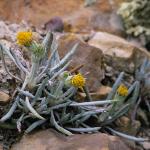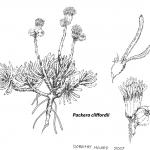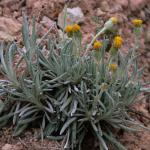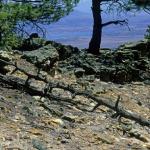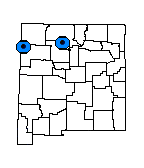Packera cliffordii (Clifford's Groundsel)
Senecio cliffordii
| USFWS | State of NM | USFS | BLM | Navajo Nation | State Rank | Global Rank | R-E-D Code | NMRPTC Status | Strategy Status |
|---|---|---|---|---|---|---|---|---|---|
| S2 | GNR | 2-1-2 | R | SS |
| Overall Conservation Status | Documented Threats | Actions Needed |
|---|---|---|
| WEAKLY CONSERVED | Logging and wood harvesting |
Taxonomic studies. Status surveys on abundance, distribution and threats. |
Tufted perennial, 4-15 cm tall, forming clumps up to 2 dm across, covered with white, felty or woolly tomentum; basal leaves linear or linear-oblanceolate, 2-4 cm long, 1-3 mm wide, flat or with margins rolled inwards; stem leaves reduced to small scales; flower stems taller than basal leaves and terminated by one or three heads; flower heads about 10 mm long, involucral bracts in one or two series, green or becoming purplish at maturity; disk flowers yellow, ray flowers absent; achenes sparsely short-hairy along the longitudinal angles; pappus of white capillary bristles. Flowers April and early May.
Packera spellenbergii from the shortgrass prairie of northeastern New Mexico is similar to Packera cliffordii in general aspect, but is a smaller plant with shorter (less than 3 cm), narrower (about 1 mm), and more densely tomentose leaves. The ranges of these two species are widely separated.
New Mexico, McKinley and Rio Arriba counties; Arizona, Apache County; Utah, Kane County.
Limy mudstones or sandy soils (sometimes gypseous) in piñon-juniper woodland up to mixed conifer forest; 2,250-2,350 m (7,380-7,700 ft).
Although widely distributed, this rare plant occurs in very small, sporadic populations. It is named for Navajo botanist, Arnold Clifford.
Packera cliffordii from northwestern New Mexico and south-central Utah is included as a synonym of Packera spellenbergii in Flora of North America, Vol. 20 (Trock 2006), which would greatly extend the range of Spellenberg's groundsel. After completing her Packera treatment for Flora of North America, Deb Trock visited some populations of P. cliffordii in Arizona and New Mexico and now doubts her placement of it as a synonym of P. spellenbergii (Deb Trock email to Bob Sivinski, 2006). The NMRPTC decided at its meeting on March 30, 2007, to maintain P. spellenbergii and P. cliffordii as distinct species.
The dominant land use of livestock grazing has no direct effect on this unpalatable species. A few populations in the Chuska and Nacimiento mountains occur within ponderosa pine and Douglas fir forest and may be impacted by timber management operations.
Atwood, N.D. and S.L. Welsh. Nomenclatural proposals and taxonomic novelties. Page 838, In: Welsh, S.L., N.D. Atwood, S. Goodrich and L.C. Higgins. 2003. A Utah Flora, 3rd ed. Monte L. Bean Life Science Museum, Brigham Young University, Provo, Utah.
O'Kane, S.L. 2022. Packera cliffordii (Asteraceae), a new combination and differentiation from P. spellenbergii. Phytoneuron. 2022-3: 1–3. Published 25 January 2022.
Trock, D.K. Packera. Pages 570-602, In: Flora of North America Editorial Committee. 2006. Flora of North America, volume 20. Oxford University Press, New York.
For distribution maps and more information, visit Natural Heritage New Mexico

